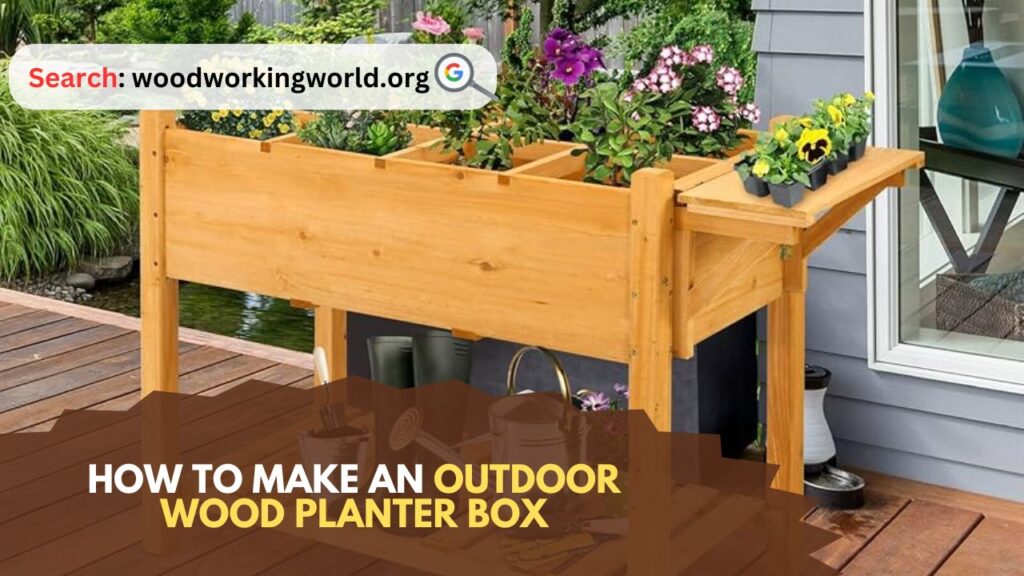Outdoor Wood Planter Box: Creating your own outdoor wood planter box is a rewarding DIY project that enhances your garden’s aesthetic while providing a functional space for your plants. Whether you’re a seasoned woodworker or a beginner, this guide will walk you through each step to build a beautiful and sturdy planter box.

How to Make an Outdoor Wood Planter Box
Materials and Tools
Before you start, gather the following materials and tools:
Materials:
- Wooden boards (cedar, redwood, or pressure-treated lumber)
- Wood screws or nails
- Wood glue
- Landscape fabric or plastic liner
- Exterior wood stain or paint
- Sandpaper
Tools:
- Tape measure
- Pencil
- Saw (circular or hand saw)
- Drill
- Screwdriver
- Clamps
- Hammer (if using nails)
- Paintbrush or roller
Step-by-Step Guide
Step 1: Plan and Measure
The first step in any woodworking project is planning. Decide on the size of your planter box. A common size is 4 feet long, 2 feet wide, and 2 feet high, but you can adjust these dimensions to fit your space.
- Length: Measure and cut four boards to the desired length (e.g., 4 feet).
- Width: Measure and cut four boards to the desired width (e.g., 2 feet).
- Height: Measure and cut four boards to the desired height (e.g., 2 feet).
Ensure that your measurements are accurate and mark the wood with a pencil before cutting.
Step 2: Cut the Wood
Using your saw, carefully cut the boards according to your measurements. If you’re using a circular saw, make sure to wear safety goggles and follow all safety precautions. Sand the cut edges to remove any splinters and create smooth surfaces.
Step 3: Assemble the Frame
Start by assembling the frame of your planter box.
- Create the sides: Attach the length boards to the width boards to form two rectangular frames. Use wood screws or nails to secure them. Apply wood glue to the joints for added strength before screwing or nailing.
- Connect the frames: Stand the two frames upright and connect them using the height boards. Secure the boards at each corner with screws or nails, forming a rectangular box.
Use clamps to hold the boards in place while you drill and screw or nail them together.
Step 4: Reinforce the Structure
To ensure your planter box is sturdy, add extra supports:
- Add corner supports: Cut four additional boards to fit the height of your planter box. Attach these inside each corner of the box using screws or nails.
- Install bottom slats: Cut several boards to fit the width of the box and attach them across the bottom, leaving small gaps between each board for drainage.
Ensure that all screws or nails are flush with the wood to avoid any sharp edges that could injure you or damage the liner.
Step 5: Sand and Finish
Sand the entire planter box to smooth out any rough spots and prepare the wood for finishing. Pay special attention to corners and edges.
- Apply wood stain or paint: Choose an exterior wood stain or paint to protect the wood from the elements. Apply it evenly with a brush or roller, following the manufacturer’s instructions. Allow it to dry completely before proceeding.
Step 6: Line the Planter Box
To prolong the life of your planter box and protect the wood from moisture, line the inside with landscape fabric or a plastic liner.
- Measure and cut: Cut the liner to fit the inside dimensions of the box. Make sure it extends slightly above the top edge of the planter.
- Attach the liner: Use a staple gun to secure the liner to the top edge of the planter box. Trim any excess material.
Step 7: Add Drainage Holes
Proper drainage is essential to prevent water from accumulating at the bottom of your planter box.
- Drill holes: Drill several small holes through the bottom slats and liner, spaced evenly apart. This will allow excess water to escape, keeping your plants healthy.
Step 8: Fill and Plant
Now that your planter box is complete, it’s time to fill it with soil and plants.
- Add gravel: Place a layer of gravel or small stones at the bottom of the planter box to improve drainage.
- Add soil: Fill the box with a high-quality potting mix, leaving a few inches of space at the top.
- Plant your greenery: Choose plants that are suitable for your climate and the location of the planter box. Arrange them in the soil and water thoroughly.
Maintenance Tips
To ensure your outdoor wood planter box lasts for years, follow these maintenance tips:
- Regularly check for rot: Inspect the wood periodically for signs of rot or damage. If you notice any issues, repair or replace the affected parts promptly.
- Reapply stain or paint: Over time, the finish on your planter box may wear off. Reapply stain or paint as needed to maintain the wood’s protection.
- Keep the soil healthy: Replace the soil every few years to keep it nutrient-rich. Remove any dead plants and add compost to replenish nutrients.
Design Variations
Once you’ve mastered the basic planter box, you can experiment with different designs and features to suit your garden’s style.
- Add legs: Elevate your planter box by attaching legs to the bottom. This can improve drainage and make gardening more accessible.
- Incorporate a trellis: Attach a trellis to the back of the planter box to support climbing plants like tomatoes or vines.
- Customize the shape: Create planter boxes in various shapes, such as L-shaped or triangular, to fit specific garden areas or to create unique visual interest.
- Decorate the exterior: Personalize your planter box by painting designs, adding decorative trim, or attaching outdoor-friendly tiles.
Benefits of DIY Planter Boxes
Building your own outdoor wood planter box comes with several benefits:
- Cost-effective: DIY planter boxes are often more affordable than store-bought ones, especially if you use reclaimed or leftover wood.
- Customization: You can design the planter box to fit your specific needs and preferences, from size to style.
- Satisfaction: Completing a DIY project gives a sense of accomplishment and allows you to showcase your woodworking skills.
- Environmental impact: By building your own planter box, you can choose sustainable materials and practices, reducing your environmental footprint.
Conclusion: Outdoor Wood Planter Box
Creating an outdoor wood planter box is a fulfilling project that enhances your garden’s beauty and functionality. With the right materials, tools, and a bit of patience, you can build a durable and attractive planter box that will provide a perfect home for your plants. Whether you stick to a basic design or get creative with custom features, your handmade planter box will be a testament to your craftsmanship and love for gardening. So roll up your sleeves, gather your tools, and start building your own outdoor wood planter box today!
I hope this article on Outdoor Wood Planter Box has been helpful. If you have any further questions, please feel free to leave a comment below.
Video
